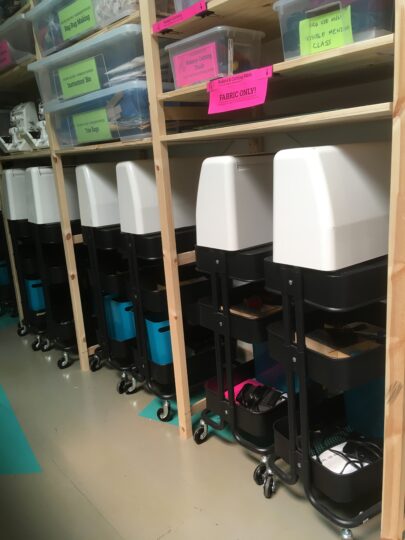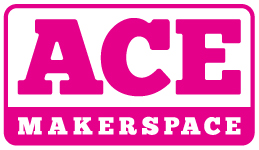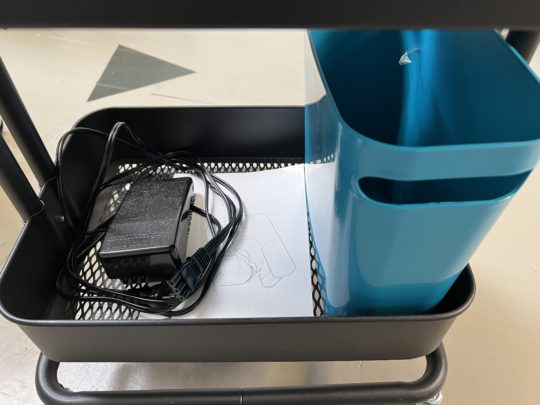Everything you need to know about the modular sewing machine carts and how to use them.
Mobile Cart Storage
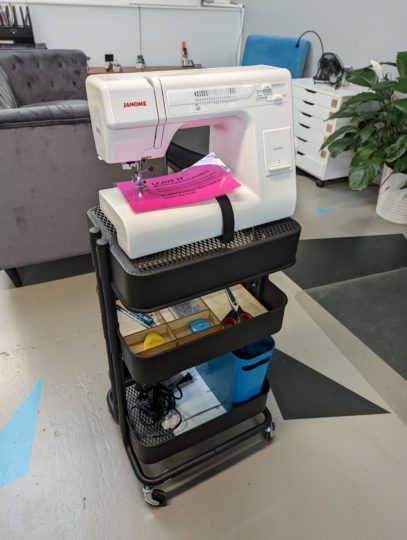
Each machine is stored covered and strapped to a cart to ensure it does not tip off when moving throughout the room.
Tools and Parts stored on the carts
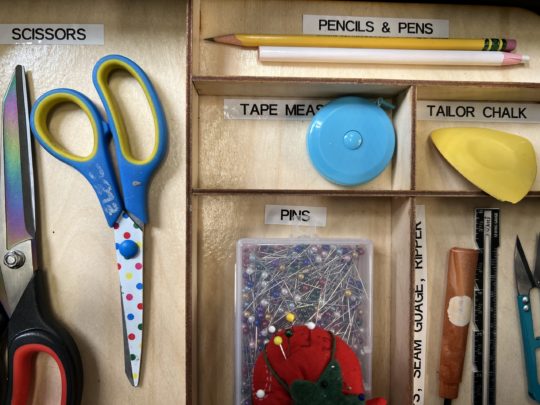
- Fabric Scissors: Fabric scissors are scissors specially designed to cut fabric. They have a sharper blade with a steeper angle and are often made from tough carbon steel that lasts longer than stainless steel and can be sharpened better. They also have longer blades for long smooth cuts.
- Seam gauge: A seam gauge is a ruler, typically 6 inches long, used for measuring short spaces. It is typically a metal scale, marked in both inches and centimeters with a sliding pointer, similar in use to a caliper. It is used to mark hems for alterations as well as intervals between pleats and buttonholes and buttonhole lengths. It can be also used as a compass to draw arcs and circles by anchoring the slider with a pin and placing the tip of a marking pencil in the hole located at the end of the scale.
- Seam Ripper: A seam ripper is a small sewing tool used for cutting and removing stitches. The most common form consists of a handle, shaft and head.
- Measuring Tape: Also known as a tailor’s tape, sewing tapes are ultra-flexible that mold easily to the body. They are used for accurate measurements for clothing design and alterations. They range in length from 60 to 120 inches. They also have both imperial and metric measurement markings.
- Fabric Pencil: The fabric marking pencil (or “spit pencil”) is a key ingredient to every maker’s workshop. For use with a range of woven or vinyl fabrics, the fabric pencils mark clearly and the markings are easily removed with a wet cloth. Featuring a white, chalk-like lead, they come in soft and firm lead options.
- Thread Clipper: Thread clippers are small scissors used for nipping excess thread and parts of the fabric that have frayed or unraveled. … These scissors also have notches on their blades, which allow you to make the buttonholes without cutting the edge of the fabric.
- Instruction Manual: This is a hard copy reference manual for the machine, which can also be found online.
- Foot Pedal: The foot pedal of your sewing machine determines the control of speed; the more pressure you apply, the more your pedal will go down, and the more you press down, the faster the machine works.
- Scrap Bin: The scrap bin is provided as a receptacle to collect fabric scraps and loose thread during sewing.
Accessories stored on the machines
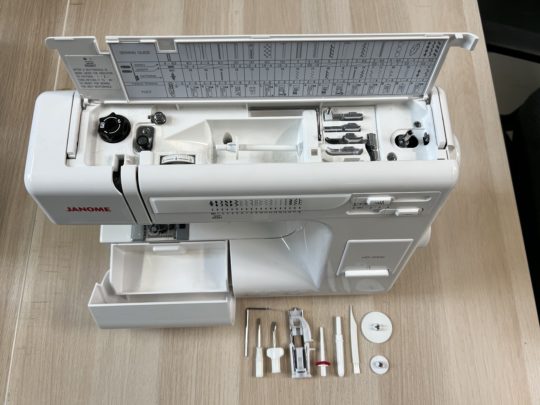
Machines are stored with the following parts in the top of the machine:
-
- Blind Stitch Hem Foot (G)
- Hemmer Foot (D)
- Zipper Foot (E)
- Transparent Buttonhole Foot (B)
- ZigZag/Standard Foot (A)
- Overedge Foot (C)
- Set of Universal Needles
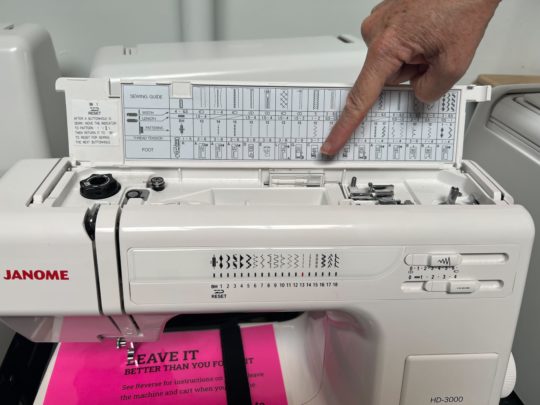
Machines are stored with the following parts in the attached storage box (pictured on the table from L to R in the image below):
- Quilting Guide Bar
- 2x screwdrivers
- Automatic Buttonhole Foot
- Extra Spool Pin
- Seam Ripper
- Lint Brush
- 2x Spool Holder (large & small)

Use, set-up, and storage
Ensure that you follow the hot pink carded instructions to leave the machines better than you found them prior to storing:
- Empty the trash. If the room’s trash is also full, please plan on taking it out and replacing the bag. Bags can be found under the sink.
- Return the thread & bobbin. On the storage wall, there is a set of drawers for thread organized by color and the bottom two drawers are for bobbins. The machine should be thread and bobbin free upon storing.
- Remove the needle and foot and return them to the storage section at the top of the machine.
- Return the foot pedal/power cord, manual, & trash bin to the bottom of the cart. Please be neat with the cord.
- Return any machine parts to the machine. This includes putting any loose feet back in the top of the machine, the spool holder back on the spool pin or in the accessories tray (attached to the machine) and re-attaching the accessories tray if detached.
- Return all cart supplies. The sections are labeled with which tools go where. Please keep them neat.
- Strap down the machine and return to the cart storage area. Make sure the hot pink card is stored under the presser foot. See the Textiles Storage Wiki for photos on how to store machines so they all fit without blocking walkways.
